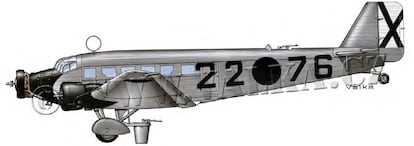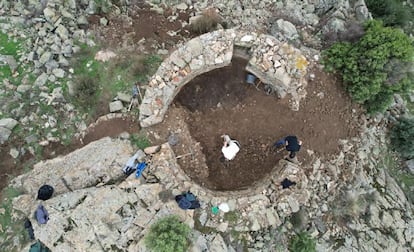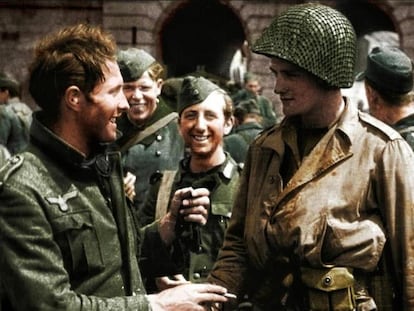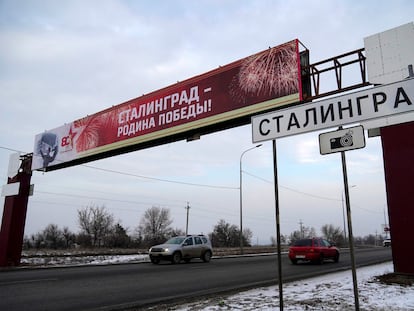First Nazi bomber to be shot down at night discovered on Spanish Civil War front in Madrid
Republican Soviet fighters shot down a Condor Legion Junkers during the Battle of Brunete but the location of the wreckage remained a mystery for 85 years


Although radar was invented in 1935, during the Spanish Civil War (1936-1939) it was not sufficiently developed to be of much use in detecting and shooting down an aircraft at night. However, on July 25, 1937, the stars aligned for Republican forces. There was a full moon and two Soviet aircraft waiting for a Junkers Ju-52 of the German Condor Legion – provided by Hitler to bolster the air forces of Nationalist General Francisco Franco – to pass by at the same time and in the same place as it did every day. As soon as its silhouette was spotted against the light of the moon, Russian fighters of the Republican Air Force descended and strafed its fuel tank, the most vulnerable spot on the transport plane as it was unarmored. The Junkers went down in flames in what was the first instance in history of a Nazi aircraft being shot down at night and only the second time that had been achieved at the point: a night-time downing of a World War I plane in 1918 was already on record.
But, where did the stricken Junkers hit the ground? It is a question that had remained unanswered for 85 years until archeologists Jorge Morín and Luis Antonio Ruiz Casero published a paper detailing their successful search for the aircraft, which was located in Santa María de la Alameda, in Madrid. As well as sections of the fuselage, the researchers uncovered coins and bullets: “A milestone in aviation history,” as the archeologists put it.

The Madrid regional government’s General Directorate of Heritage of the Community of Madrid commissioned the consulting firm Audema to investigate the so-called Zorrerón-Cerro Pelado Position, which formed a prominent point to the north of the front lines of the Battle of Brunete. At the end of July, 1937, this ferocious engagement to the southeast of the capital was entering its final stages, with heavy losses being suffered by Republican forces. Franco’s Nationalists had deployed the Condor Legion at Brunete, which tipped the balance of air superiority in their favor.
The Condor Legion carried out bombings raids incessantly, night and day, leading the commander of the Republican Air Force, Ignacio Hidalgo de Cisneros, to set up a system of nighttime defenses to hinder the actions of the enemy bombers. “In an era prior to the implementation of radar, shooting down an aircraft in night combat was virtually impossible,” say the researchers.
However, the Republicans had an ace up their sleeve. They had noticed that, on consecutive nights, a German Junkers flew over the sky of Santa María de la Alameda at the same time, heading for Alcalá de Henares and Colmenar Viejo in the Republican zone where it bombed the civilian population. They decided to wait for the right moment and two Polikarpov I-15 fighters, stationed at a provisional airfield, would lie in wait in the air.

Pilots Mikhail Yakushin and Anatoli Serov carried out the attack. Serov flew at 2,000 meters while his compatriot ascended to 3,000m, an altitude that allowed him to identify the enemy aircraft in the distance by the flash of its engines. Yakushin then positioned himself to the right-hand side of the Junkers and fired at its fuel tank. The bomber was immediately engulfed in flames and although it responded with a machine gun burst, it was too late. The Junkers went into a tailspin, crashed in the Guadarrama mountains, and exploded. Of the four crew members, only one survived, and he was captured by a Republican patrol.
Yakushin and Serov were hailed as heroes and the media gave the action plenty of coverage. The Russian pilots received gold watches and automobiles from Republican President Juan Negrín and were promoted to the rank of captain.
In 1977, the former Republican commissary Eugenio Rubio Zori, who helped guide the two Russian fighters safely back to the ground using the headlights from cars and trucks, described the Condor Legion prisoner: “He was a starving German. The signals section had to be held back because some had lost relatives in [bombing raids over] Colmenar Viejo. He didn’t know what was going, he kept asking for Salamanca, Salamanca [in the Nationalist zone]. I told him: ‘Not Salamanca, you prisoner, prisoner of the Republic, look at the emblems. Me, war commissary; this one [pointing to the commander the Santa María de Alameda post, Francisco Sebastián], Republican officer.’ The poor man began to cry. From the first moment we felt only compassion for him.”

After the Civil War ended, the Nazi regime erected a memorial to its dead airmen. However, it was not placed where the Junkers went down but by the side of the road that traverses the area so that it could be seen by motorists. A few years ago, it was vandalized. However, with information recorded by Zori and a report on the incident kept at the Military Archives in Ávila, which contain the coordinates of the wrecked plane according to the Lambert System, the researchers were able to locate it, says Ruiz Casero.
Sign up for our weekly newsletter to get more English-language news coverage from EL PAÍS USA Edition
Tu suscripción se está usando en otro dispositivo
¿Quieres añadir otro usuario a tu suscripción?
Si continúas leyendo en este dispositivo, no se podrá leer en el otro.
FlechaTu suscripción se está usando en otro dispositivo y solo puedes acceder a EL PAÍS desde un dispositivo a la vez.
Si quieres compartir tu cuenta, cambia tu suscripción a la modalidad Premium, así podrás añadir otro usuario. Cada uno accederá con su propia cuenta de email, lo que os permitirá personalizar vuestra experiencia en EL PAÍS.
¿Tienes una suscripción de empresa? Accede aquí para contratar más cuentas.
En el caso de no saber quién está usando tu cuenta, te recomendamos cambiar tu contraseña aquí.
Si decides continuar compartiendo tu cuenta, este mensaje se mostrará en tu dispositivo y en el de la otra persona que está usando tu cuenta de forma indefinida, afectando a tu experiencia de lectura. Puedes consultar aquí los términos y condiciones de la suscripción digital.
More information
Archived In
Últimas noticias
Most viewed
- Alain Aspect, Nobel laureate in physics: ‘Einstein was so smart that he would have had to recognize quantum entanglement’
- David King, chemist: ‘There are scientists studying how to cool the planet; nobody should stop these experiments from happening’
- Maps of the US attack on Venezuela: Targets, airspace and deployed fleet
- Key points of the military attack on Venezuela: Early morning bombings and a ‘captured’ president
- Mexico completes its trade shift with the entry into force of tariffs on China and countries without trade agreements










































